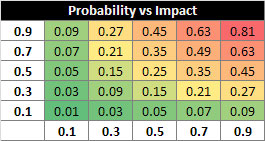I’ve been thinking about how I do things in my life and found out that I have a built in mechanism on how I deal with risk. For those of you who don’t know, risk is, as defined by dictionary.com, “exposure to the chance of injury or loss; a hazard or dangerous chance.” I’d like to throw in that risk can also have a positive impact but that’s another post I need to do.
Here’s my internal mechanism for risk. Will it work, yes, do. Will it work, no, don’t do. These are my simple rules of risk and now that I think about it, I’m pretty risk adverse. Here’s how real project managers handle risk.
Project managers make a list of risks, the probability of hit happening, and the impact it will have in the overall project.
The list will probably look something like this:
Location: Tropical Island
Date: September to December
| Risk |
Probability
|
Impact
|
Total
|
| Tornado |
0
|
.9
|
0
|
| Typhoon/Hurricane |
.5
|
.5
|
.5
|
In this list you’ll mark down what the probability of it happening. A value ranging from 0 to 1, so .1, .2, .3, etc… And then you’ll do the same for the impact. Impact is how much damage is done if the risk actually happens.
Let’s take a look at the risks above:
Tornado: The probability is 0 because we live on an island. The impact is .9 because if there ever was a tornado on an island it would case a lot of damage.
Typhoon/Hurricane: The probability is .5 because it’s definitely possible. The impact is .5 because people living on island are generally ready for typhoons/hurricanes.
The next step is then to multiply the probability and the impact and then place it on the chart. If you have a lot of dots in the red zone you might want to put more effort in planning how you’re going to respond to them.




